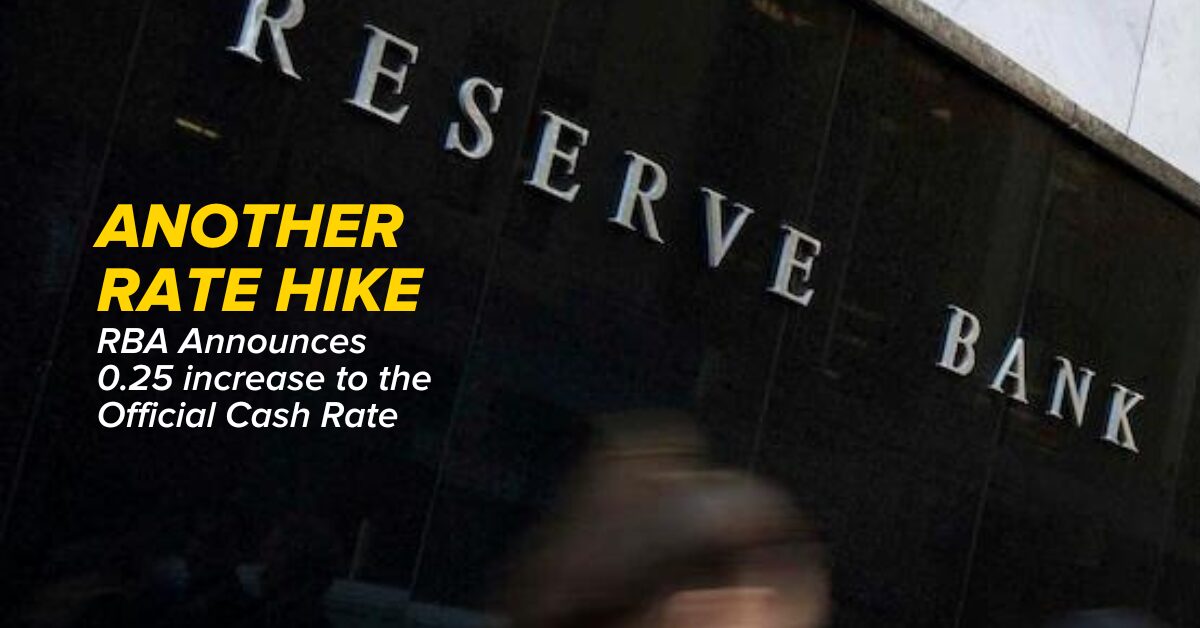In this article:

Overview of the RBA’s decision to raise interest rates
The RBA Board has officially decided to increase the cash rate by 25 basis points to 3.85%.
How this impacts mortgage holders in Australia
The decision to increase the official cash rate will leave many mortgage holders scratching their heads, after just one month of respite from the rate hiking cycle.
This means a return to rising interest rates and soaring mortgage repayments for many borrowers.
Say for example your home loan interest rate were to increase from 5.75% to 6.00%, you would experience an increase of $15.98 per month, per $100,000 borrowed, in terms of minimum monthly repayments over a 30 year loan term. For example:
- Repayment increase on a $400,000 loan = $63.92
- Repayment increase on a $600,000 loan = $95.88
- Repayment increase on a $800,000 loan = $127.84
The big question is why go back to rate rises?
According to the statement by RBA Governor Philip Lowe, Inflation is still too high despite reaching its peak.
“Given the importance of returning inflation to target within a reasonable timeframe, the Board judged that a further increase in interest rates was warranted today,” Lowe’s statement said.
“The Board held interest rates steady last month to provide additional time to assess the state of the economy and the outlook. While the recent data showed a welcome decline in inflation, the central forecast remains that it takes a couple of years before inflation returns to the top of the target range…”
The RBA has made it clear that any future decisions on the official cash rate will be based on the inflation outlook, so it is important for borrowers to keep an eye on economic developments in order to make the most of their mortgage:
“The Board’s priority remains to return inflation to target. High inflation makes life difficult for people and damages the functioning of the economy. And if high inflation were to become entrenched in people’s expectations, it would be very costly to reduce later, involving even higher interest rates and a larger rise in unemployment,” read Lowe’s statement.
Luckily, we’ve collected all the information you need, in one place: YBR Home Loans’ Rate Watch. You can also tune in monthly to Property Insights with Mark Bouris and leading economist, Stephen Koukoulas, where they explain what the data means, and give you their predictions on where interest rates may be headed.
Property Market on the turn?
In more positive news for homeowners, CoreLogic’s Home Value Index results for April have been released, showing steady growth in property prices across Australia for the second consecutive month.
Australian dwelling values rose by 0.5% in April, following an increase of 0.6% in March, according to CoreLogic’s Home Value Index.
CoreLogic’s research director Tim Lawless said the consecutive monthly increase in home values is evidence that the property market may have bottomed out.
“Not only are we seeing housing values stabilising or rising across most areas of the country, a number of other indicators are confirming the positive shift. Auction clearance rates are holding slightly above the long run average, sentiment has lifted and home sales are trending around the previous five-year average,” Lawless said.
“Typically, we wouldn’t see housing values start a new growth cycle until monetary policy started to ease, credit policies loosened or some level of fiscal support was introduced. The shift towards more positive conditions has come about in the absence of these factors.'”
So what are the factors contributing to the shift in house prices nationally?
Lawless said that there is a growing expectation from commentators and consumers alike that the rate hiking cycle is either over, or soon to be over, which may contribute to an increased demand for housing, and therefore an increase in the value of properties.
He also added, “Many prospective vendors have stayed on the sidelines through the downturn, keeping inventory at below average levels and providing sellers with some leverage at the negotiation table.”
“This could be contributing to a broader perception that the market has bottomed out, and for those attempting to time the market, that it is considered to be a good time to buy,” he said.
“As interest rates stabilise there is a good chance consumer sentiment will improve, bolstering housing market activity from both a purchasing and a selling perspective.”
RBA Review: Will it make a difference to consumers?
The independent review into the Reserve Bank of Australia (RBA) released its findings several weeks ago, providing a comprehensive assessment of the RBA’s operations, structure and policies.
The review was conducted by an expert panel with the aim to assess how effectively the RBA is meeting its objectives in setting monetary policy.
Bouris and Koukoulas discussed what impact these recommendations will have on consumers and whether it will make a difference to the everyday lives of Australians:
“Not much a difference at all,” said Koukoulas.
“To just summarise, they’re keeping the 2% to 3% inflation target. So that’s unchanged. There has been almost no discussion about that other than ‘it sort of worked for the last 30-odd years. So let’s keep it to the things that are more procedural.'”
“There’s going to be a specific monetary policy board who will make the decisions rather than the existing Reserve Bank Board.”
On this new board, the recommendations suggest that there will be Government-appointed ‘monetary policy experts’.
“What’s that mean?” said Mark Bouris.
Koukoulas replied, “Good question.”
“Jim Chalmers, if you’re watching, I’d love to be on the board. But it will be people who’ve got financial markets knowledge, who know which way it works, and academic economists.”
“The RBA has to be a little bit careful, because they have 400 academic economists working for it, so in a sense, you don’t need them to recheck the modelling, rather, you need people with real world experience.”
“And dare I say, people with knowledge of how the economy works: what will be the impact of rate hikes or rate cuts? That’s the sort of thing that’s going to be the role of the board.”
“And the other thing that is noteworthy: instead of 11 Board meetings a year, every month, except January, there’s only going to be eight board meetings.”
Why?
“I think they tried to avoid the problem that has happened for at least four of the board meetings at the moment. And that’s having a board meeting after the GDP numbers come out. So they haven’t quite formulated this yet. But what they’re going to be aiming to do is to have a board meeting two weeks after each quarterly inflation number.”
“That gives the board two weeks to analyse those numbers. ‘Do we hike? Do we cut? What do we do with these numbers?’ Rather than the first Tuesday of every month when sometimes not much happens. So it’s a bit more like the US system where they meet a little bit less often, but with a lot more information when they make the decision.”
The RBA’s decision to hold interest rates and the independent review into its operations, structure and policies could eventually spell good news for mortgage holders in the long run. We will have to wait and see just how and when these recommendations will be implemented.
If you are interested in understanding how today’s RBA decision may impact your home loan situation or you would like to explore your options to ensure you’re getting the best deal possible, reach out to us today.



